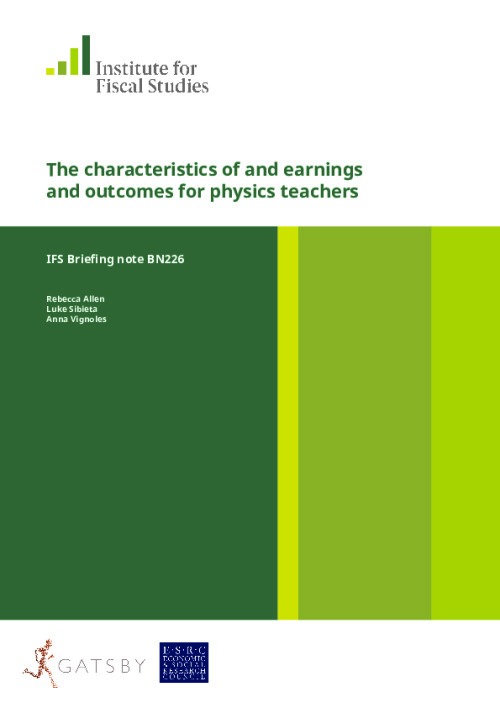Executive Summary
Key findings
- Teaching is not a popular destination for physics teachers. Only around 3% of physics graduates enter teaching in the first few years after graduation. In mathematics, by contrast, more than one in ten graduates become teachers in the years immediately after graduation.
- Physics teachers are, on average, as well qualified as other teachers, at least as measured by their prior attainment level on entry into university (UCAS tariff points).
- While the quantity of physics teachers appears to be an issue, the quality does not appear to be a problem.
- Physics graduates have better outside options in the labour market and generally earn more than graduates with many other degree subjects. However, despite this we find no evidence that schools are paying physics teachers more than teachers in non-shortage subjects.
- Physics graduates generally have higher quit rates both from their school and from the profession as a whole, as compared to other subject areas. 40% of physics graduates who are teaching 6 months after graduation leave the profession within 3.5 years of graduation.
- The physics teacher workforce is older and more experienced than for other subjects as a consequence of the recruitment issues and high quit rate.
- Around half of all those who are teaching science have “other” science degrees, rather than traditional science subjects. This may reflect the fact that it is easier to recruit and retain these individuals.
- Schools employ a relatively large number of teachers with physics or engineering degrees who do not appear to be teaching, a phenomenon that requires better understanding, along with further investigation of the School Workforce Census.
- Data on the effectiveness of different routes into teaching is partial. It is difficult to track trainees from different initial teacher training routes into specific schools (and out again) and to distinguish between those who exit teaching altogether from those who join the private school sector. Identifying those who enter teaching through the Schools Direct and Teach First routes is still difficult.
Implications
- Physics teachers have higher levels of prior attainment and better labour market options. If schools are to recruit and retain such individuals, the total reward package offered to them should be attractive. This includes non-pecuniary benefits as well as financial benefits. Indeed, physics teachers also move schools more rapidly than other teachers. This might, given that they do not move for higher pay on average, indicate that non-pay factors and job quality are push or pull factors in these moves.
- Only a very small proportion of people teaching science have a specialist degree in physics. We need more robust evidence on the impact of being taught by a specialist teacher. While a number of research studies appear to suggest that the degree subject does not impact on students’ test score gains in that subject, the evidence base on this issue is partial. We do not know what the broader impact of having a specialist teacher is on engagement with the subject and likelihood of taking it at A-Level and degree level.
- Much has been made of bursaries as a key lever to attract physicists into teaching. We did not evaluate the impact of the bursary scheme in this report, but our findings do suggest that high turnover and low retention of these teachers is likely to be a significant problem. Hence when policy is being developed to tackle this issue, a more holistic approach that considers both recruitment and retention, and pay and non-pay issues, is likely to be more successful.
- Recent reforms (EBacc, new GCSEs and the Progress 8 accountability measure) may increase the emphasis on students with higher levels of academic achievement. It is unclear whether this will increase schools’ demand for specialist teachers. Given financial conditions, even if demand for such teachers increases, it appears unlikely that schools could use financial incentives to attract and retain them. Again this might suggest non-pecuniary aspects of the job will need to be enhanced.
Future research
- Further research is needed (and better data and data linkage) to determine factors that affect the quit rate of physics teachers and to determine whether physics teachers who enter the profession via different routes have markedly different quit rates.
- We need better evidence on the non-pecuniary aspects of science teaching roles. For example, do science teachers have the same opportunities to engage in pastoral work and to earn teaching and learning responsibility payments?
- We need to continue to build the evidence base on effective interventions to retain physics teachers, including the role of mentoring and leadership.
- We need to improve our understanding of how schools value specialist teachers, particularly in physics, and what do they do to retain them. Do schools use the full range of levers that they have at their disposal (pay, reduced timetable, professional development opportunities) to try to retain physics teachers and if not, why not? Alternatively do schools prefer generalist science teachers because they are more likely to retain them? More generally, are there barriers to retaining specialist teachers that still need to be identified?
- More generally, we still need to improve the data we have on who becomes a teacher, the nature of their initial training, the extent of their professional development and how they move around the system. For example, using a unique identification number to enable us to follow graduates as they become teachers and move around the state and private school system would improve our ability to research key questions on this topic.










